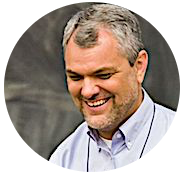Venus envy
- June 06, 2012
- By Dale McGowan
- In Atlanta, My kids, Science, wonder
 2
2
 When I was 10, my dad tried to show me Comet Kohoutek, which was unfortunately a fizzle, at least where we were. But we saw a lot of other cool things over the years, and he taught me to watch the sky.
When I was 10, my dad tried to show me Comet Kohoutek, which was unfortunately a fizzle, at least where we were. But we saw a lot of other cool things over the years, and he taught me to watch the sky.
My daughter Delaney is now 10, and she’s been a skywatcher from the start. I wanted to show her the last transit of Venus for 105 years, which happened yesterday, but it rained pretty much all day. Which reminded us both of something I told her years ago.
Guillaume Le Gentil was part of one of the most unimaginable scientific undertakings ever. Somebody in the 17th century, I can’t even remember who or how, realized that Venus crosses the disc of the Sun twice, eight years apart, then repeats the pair about 105 years later. Then somebody in the 18th century — Ed Halley, I think it was — figured out that viewing the transit from different parts of the globe, and taking accurate measurements of when Venus enters and exits the disc, and comparing the readings, could help us figure out the distance from Earth to the Sun, which could then be used to figure out every other astronomical distance in the solar system. And that the next opportunity to do this would be in June 1761.
May I just say this about myself. If I’d been sitting in the bar with Halley, and I’d heard this, I would have found it very interesting, then gone back into me pint. “If only this weren’t the bleedin’ 18th century,” I might have funk to meself.
Fortunately, better folks than I were there, and they started chanting the Nike slogan, then made plans to dispatch over 100 observers all around the planet, in the 18th century, to figure out how far away the Sun is.
One of the dispatched was a French astronomer named Guillaume le Gentil, who left Paris a year before the transit and headed for a spot on the southeast coast of India called Pondicherry. He was delayed in landing by an extended naval skirmish, part of the Seven Years’ War. Weeks passed, then Transit Day came and went with le Gentil trapped on a rocking ship, unable to take useful measurements.
Instead of returning home, he decided he might as well hang out until the next transit eight years later, on June 4th, 1769. He killed some time mapping Madagascar, then returned to Pondicherry, built himself a little observatory, and bided his time.
June 4th dawned bright and clear, and le Gentil sat with growing excitement in his observatory, waiting for the transit.
Moments before it began, a cloud rolled over the sun. The view remained obscured for the duration of the transit, then cleared nicely when it was too late. Le Gentil nearly lost his mind. Honestly, who wouldn’t.
Then things got worse. He decided to return home, but first got dysentery and had to miss his ship. He got better, then caught another ship, which wrecked off the coast of Réunion. He made it to shore, then eventually caught a Spanish ship home. He arrived in Paris eleven years after he left, only to learn he’d been declared dead and had lost his coveted seat in the French Academy of Sciences. His wife had remarried — although seriously, can you blame her? — and everything he owned had been sold off.
He essentially sued everyone, got his stuff back, got back into the academy, got him a new wife, and did just fine. But he never saw the transit of Venus. And after about 18 hours of clouds and rain, it looked like we wouldn’t either.
But then, then, just as the transit began yesterday at 6pm, I saw a sudden brightness outside. I jumped up from the dinner table, threw together a pinhole camera and ran out to the front yard with Laney in tow. Sure enough, after about five minutes of focusing and refocusing, Laney and I saw that tiny magic dot and screamed.
We walked back inside. My wife was still there, and no one had eaten my tilapia. In the history of transit-watching, that counts as a win.



